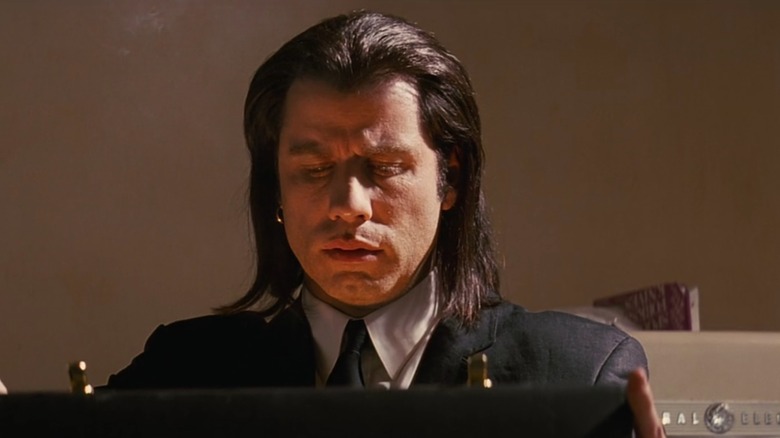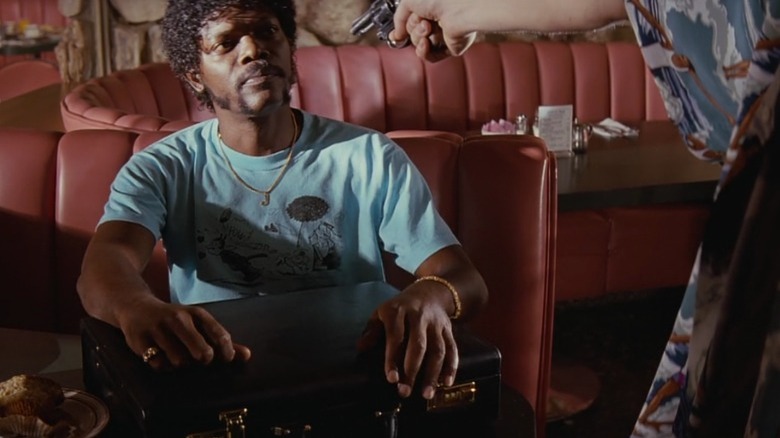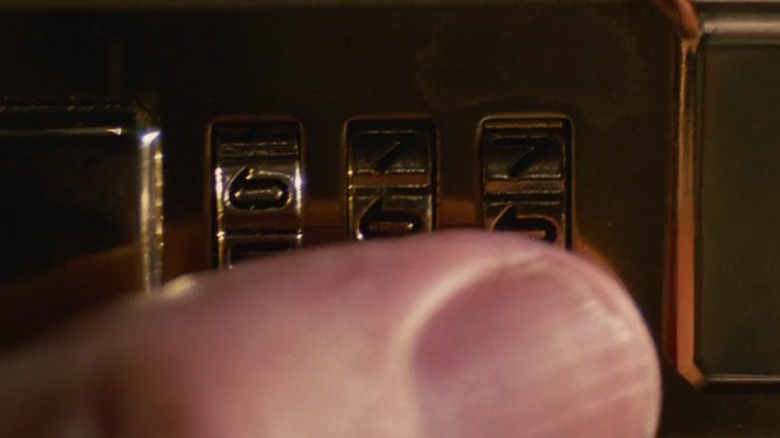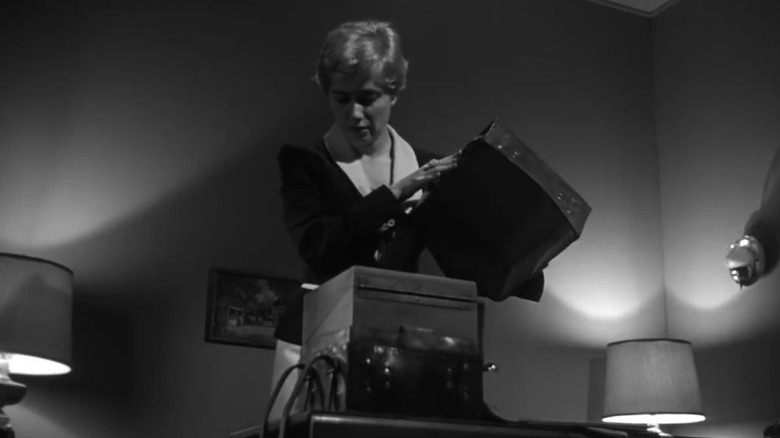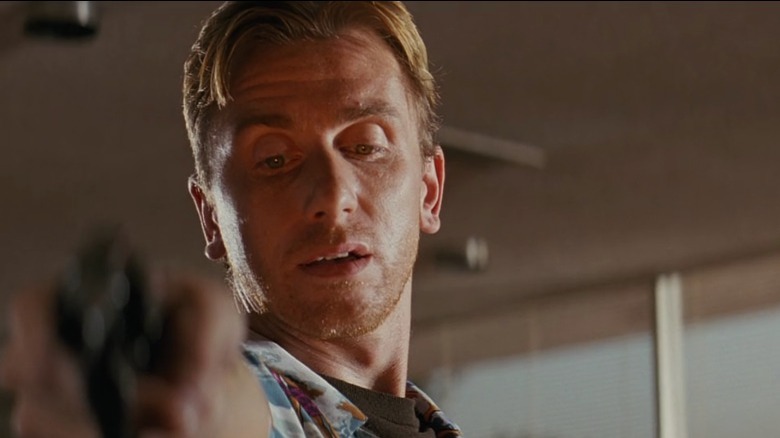The Final 'What Was In The Briefcase In Pulp Fiction?' Story You Will Ever Need
Let's get something out of the way up front here: there is no right answer to the question "What was in the 'Pulp Fiction' briefcase?" There's no wrong answer, either. For nearly 30 years now, movie lovers have been experiencing the thrill of watching Vincent Vega (John Travolta) unlatch the lock on the coveted case and gaze upon the reflective gold glow of its contents, which the camera never reveals. The "Pulp Fiction" briefcase stays closed to the audience, but that doesn't mean we can't think about what's inside of it. In fact, the briefcase, more than most other movie props in history, serves as a perfect litmus test for curious viewers, as it asks us to stretch our own film analysis muscles to come up with an answer independent of writer-director Quentin Tarantino's own intentions.
But what were those intentions exactly? The filmmaker who would go on to craft movies that defined the "indie" label, like "Kill Bill" and "Death Proof," has been upfront about the fact that the briefcase is meant to encourage — or require — personal interpretation. Tarantino explained as much in an interview with Charlie Rose in 2009. The filmmaker was there promoting his latest movie, "Inglourious Basterds," and used that film as a jumping-off point for a conversation about details in his films that aren't meant to be explained. "That's one of my things: whether or not the audience knows about it, I know about the character's past, and I just want the actors to know," Tarantino shared, but, "the audience doesn't need to know."
'Just figure it out, all right?'
Tarantino used the rope burn on "Inglorious Basterds" character Aldo Raine's neck as an example. "Just figure it out, all right? I mean, it's up to you to supply where that rope burn came from," he told the interviewer. He explained that if three different viewers came up with three explanations for the burn independent of one another, "those are three different movies you all saw. And I like that idea." This is a style of engaging with storytelling that's popular in certain schools of literary theory, especially in the 20th-century field of New Criticism. New Criticism, which was introduced and refined by theorists and writers like John Crowe Ransom and T.S. Eliot, presupposes that everything you need to know about a text is within the text itself. Practitioners of New Criticism would hate that an article explaining the "Pulp Fiction" briefcase even exists, but then again, Tarantino probably does, too.
"I like the idea that you open up the briefcase in 'Pulp Fiction,' and I don't tell you what's in there, but it's up to you to figure out what's in there, and now that's your movie," the filmmaker told Rose. "Pulp Fiction" is a fantastic movie for many reasons, and this is definitely one of them; its perspective shifts offer plenty of chances for viewers to meet the film on whatever level they can, and the same goes for the briefcase. It's a movie that gets people talking, but if you give it your full attention — sans Google — you'll come away with a response that feels personalized to you. It's the kind of cinematic personalization that Hollywood bigwigs chasing AI storytelling think doesn't exist yet, but it's actually been around for as long as there have been stories to tell.
It could be money, jewels, or a lost soul
Of course, there are some popular explanations for what may be in the briefcase that are worth mentioning. The object within is in high demand, and that shiny light calls to mind jewels that glisten and blind the eyes. Plus, "Reservoir Dogs" featured a diamond heist, so we know the precious gems were already on Tarantino's mind a few years earlier.
Cash is another popular option, as it's certainly the motivating factor that's caused many a person to commit violence throughout history. If the suitcase were simply full of money, the gold glow would gain a sense of irony, as it would be a sign that these characters — like many people — would see something mundane like dollar bills as in some way holy or magical.
One of the most creative briefcase theories is exactly the sort that feels designed to keep spreading in our Easter egg-happy times. As outlets like Dazed Digital have pointed out, many a die-hard fan has become convinced over the years that the briefcase actually holds the soul of Marsellus Wallace (Ving Rhames). The evidence here mostly leads back to that "666" combination, but Wallace also has a Band-Aid on the back of his neck that's displayed prominently in some shots. The theory posits that the criminal kingpin traded his soul to the devil, and the bandage hides the mark where it was removed — although there doesn't seem to be a surplus of evidence that Judeo-Christian religions see the neck as the location of the soul.
If this last theory were true, much of the movie would revolve around Vincent and Jules' (Samuel L. Jackson) attempt to get Marsellus' soul back for him. It would also mean the devil is terrible at picking passwords.
A familiar image
Anyone hoping the briefcase contained something special on set will be sorely disappointed. According to Gavin Edwards' book "Bad Motherf***er: The Life and Movies of Samuel L. Jackson," the actor has given a demystifying description of the inside of the briefcase in the past. "When I looked inside, between scenes, I saw two lights and some batteries," he revealed.
That answer may take the wind out of the sails of viewers looking for a simple explanation, but as Tarantino told Rose, the movie belongs to each viewer. "If I tell you at this table what that is [in the suitcase], you'll throw that away, and I don't want you to throw that away," he explained. "That's your movie." The lights and batteries were Jackson's version of the movie, but they don't have to be ours.
While Tarantino encourages individual interpretations, it's also worth noting that, as with all of his films, he likes a good reference. The briefcase is in the broadest of terms a reference to the idea of a MacGuffin, an object that exists only to move the plot of a story along. The prop is perhaps the purest example of a MacGuffin around, since it ties together the film's disparate plotlines and does nothing else.
The shiny visual accompanying the briefcase also has precedent; in the 1955 noir film "Kiss Me Deadly," multiple people chase after a box containing a "great whatsit." At the film's end, a woman named Gabrielle (Gaby Rodgers) opens the box, which emits a blinding light and a shrieking noise. According to The A.V. Club, Tarantino says the "Kiss Me Deadly" MacGuffin didn't inspire his own, but we know it definitely had a long legacy, with films like "Repo Man" and "Raiders of the Lost Ark" paying homage to it.
Trust yourself on this one, okay?
Tarantino again referenced the briefcase in 2019, when BBC Radio 1's Ali Plumb stumped him by asking about the wild case theories he's heard over the years. "Well, I don't really have a good answer for that because, unfortunately, the whole idea why I didn't tell people what was in the suitcase is so they would come up with it on their own," Tarantino replied, "But nobody wants to do that. They just want to know what I think, and I don't give a damn what I think." He went on to say that he's been asked countless times about what's in the case, but fewer than five people have ever approached offering up their own opinion about what could be inside.
What Tarantino's talking about here, and what ambiguity-rejecting audiences apparently didn't seem to embrace, is the idea of "the death of the author." Just as an author writes a book with a certain interpretation in mind, a filmmaker approaches a movie with a set idea in mind. But as essayist Roland Barthes outlined in his 1967 essay "The Death of the Author," authorial intent isn't the end-all, be-all of a storytelling experience, and interpretation can and often should be in the eyes of the reader or viewer. It's boring to approach a movie looking for the "right answers," and in the case of the "Pulp Fiction" briefcase, Tarantino designed the prop specifically as an open-ended question that encourages viewers to fill in the blank themselves.
So, officially, what's in the briefcase in "Pulp Fiction"? It's whatever you thought was in there before you read this article.
